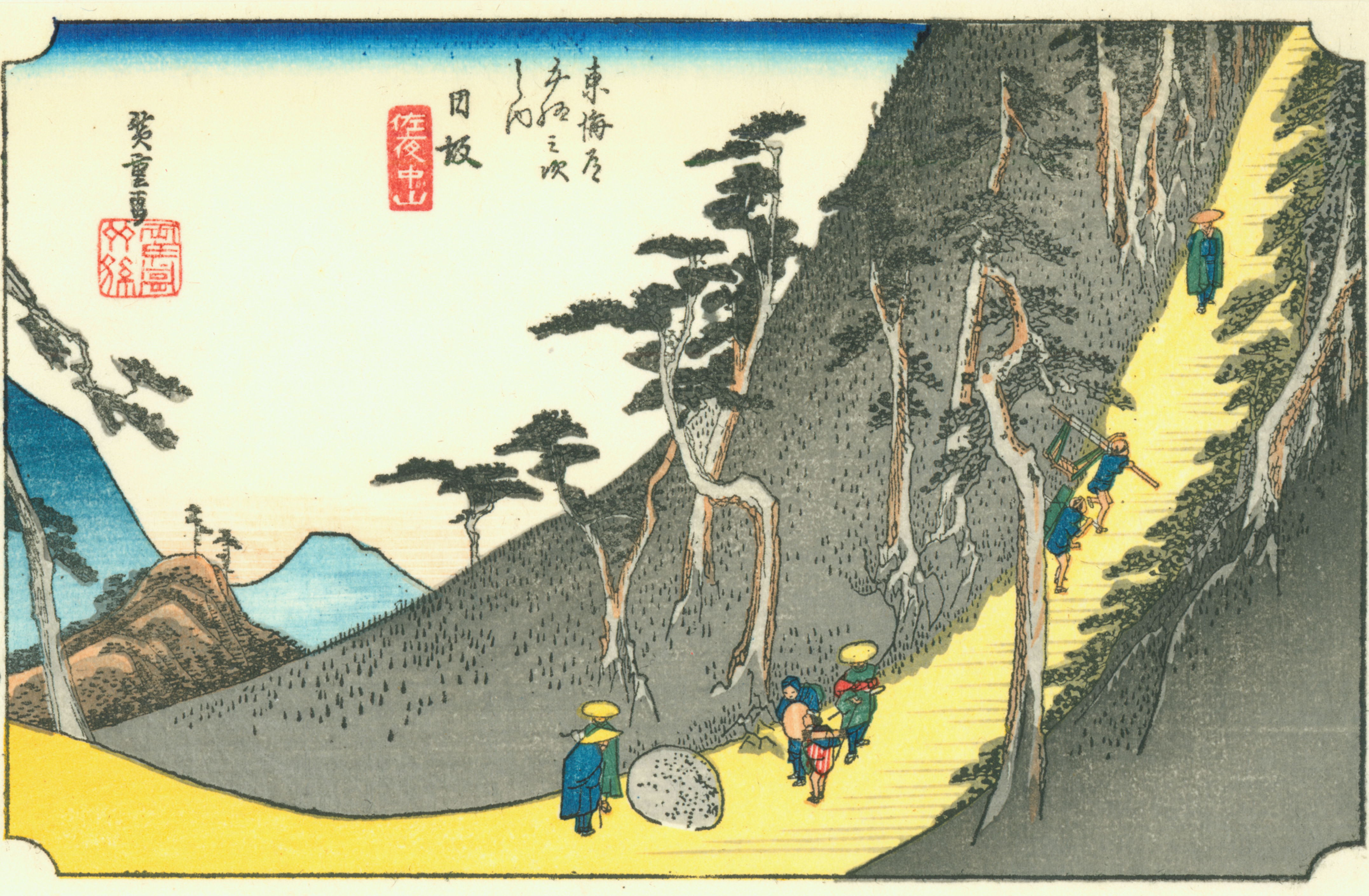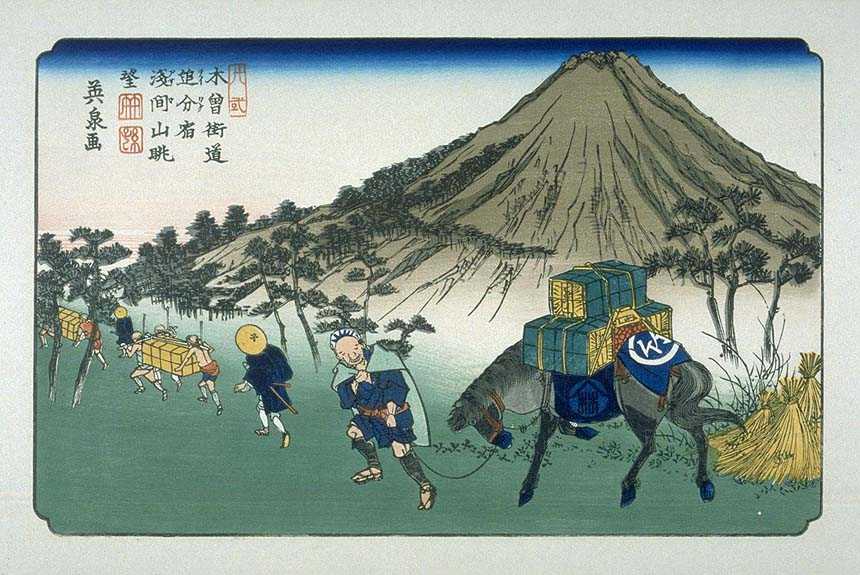|
Kanaya-juku
was the twenty-fourth of the fifty-three stations of the Tōkaidō. It is located in what is now part of Shimada, Shizuoka Prefecture, Japan. During the Edo period, it was the easternmost post station of Tōtōmi Province. History Kanaya-juku was built up on the right bank of the Ōi River across from Shimada-juku. There were over 1,000 buildings in the post town, including three '' honjin'', one sub-''honjin'' and 51 '' hatago''.Ochakaidō: History of Kanaya-juku Ochakaidō Cultural Association. November 29, 2007. Travelers had an easy travel to Nissaka-shuku, which was about away. However, whenever the river's banks overflowed, travelers were not able to pass through Kanaya and on to Shimada-ju ... [...More Info...] [...Related Items...] OR: [Wikipedia] [Google] [Baidu] |
Shimada-juku
was the twenty-third of the fifty-three stations of the Tōkaidō highway, which connected Edo with Kyoto in premodern Japan. It is located in what is now part of Shimada, Shizuoka Prefecture, Japan. History Shimada-juku was located on the left bank (Edo side) of the Ōi River, just across from its neighboring post town, Kanaya-juku. As part of the outer defenses of the capital of Edo, the Tokugawa shogunate expressly forbid the construction of any bridge or ferry service over the Ōi River, forcing travelers to wade across its shallows. However, whenever the river flooded due to strong or long rains, crossing the river became nearly impossible. During periods of long rains, visitors were sometimes forced to stay at Shimada-juku for several days, increasing the amount of money they spent. A common saying about Shimada-juku was . [...More Info...] [...Related Items...] OR: [Wikipedia] [Google] [Baidu] |
Nissaka-shuku
was the twenty-fifth of the fifty-three stations of the Tōkaidō. It is located in what is now part of the city of Kakegawa, Shizuoka Prefecture, Japan. History Nissaka-shuku was located at the western entrance to , regarded as one of the three difficult mountain passes along the Tōkaidō. At the western entrance of Nissaka-shuku is . Originally, various characters were used for Nissaka, including 入坂, 西坂 and 新坂, as it had been nothing more than a small town located between Kanaya-juku on the banks of the Ōi River and Kakegawa-juku, a castle town that was an intersection along an old salt trading route. When Nissaka-shuku was established as part of the Tōkaidō at the start of the Edo period, the characters for its name officially became 日坂. The classic ukiyo-e print by Andō Hiroshige (''Hōeidō'' edition) from 1831–1834 depicts travellers on a steep road in forbidding dark mountains contemplating a large boulder in the road. The stone was a noted la ... [...More Info...] [...Related Items...] OR: [Wikipedia] [Google] [Baidu] |
53 Stations Of The Tōkaidō
The are the rest areas along the Tōkaidō (road), Tōkaidō, which was a coastal route that ran from Nihonbashi in Edo (modern-day Tokyo) to Sanjō Ōhashi in Kyoto.. There were originally 53 government shukuba, post stations along the Tōkaidō, where travelers had to present traveling permits at each station if wanting to cross. In 1619, the Ōsaka Kaidō (大阪街道) was developed to extend the Tōkaidō so that it would reach Kōraibashi in modern-day Osaka. Instead of going to Sanjō Ōhashi, travelers would leave from Ōtsu-juku and travel towards Fushimi-juku (Tōkaidō), Fushimi-juku. Because of the addition of these four post towns, the Tōkaidō is occasionally referred to as having 57 stations. Another name for this extension was Kyōkaidō (京街道). The inland Nakasendō also started at Nihonbashi, and converged with the Tōkaidō at Kusatsu-juku. Shio no Michi intersected with the Tōkaidō at Okazaki-shuku. Stations of the Tōkaidō File:NihombashiDat ... [...More Info...] [...Related Items...] OR: [Wikipedia] [Google] [Baidu] |
Shimada, Shizuoka
270px, Shimada City Hall is a city located in Shizuoka Prefecture, Japan. The city, which covers an area of , had an estimated population in September 2023 of 93,724, giving a population density of About 300 persons per km2. Geography Shimada is located in the Shida Plains of west-central Shizuoka Prefecture. It is located on both banks of the Ōi River. The area enjoys a warm maritime climate with hot, humid summers and mild, cool winters. Surrounding municipalities Shizuoka Prefecture * Aoi-ku, Shizuoka * Fujieda * Kakegawa * Kawanehon, Haibara District * Kikugawa * Makinohara * Mori, Shuchi District * Tenryū-ku, Hamamatsu * Yaizu * Yoshida, Haibara District Demographics Per Japanese census data, the population of Shimada has remained steady over the past 50 years. Climate The city has a climate characterized by hot and humid summers, and relatively mild winters (Köppen climate classification ''Cfa''). The average annual temperature in Shimada is 15.7 °C. The a ... [...More Info...] [...Related Items...] OR: [Wikipedia] [Google] [Baidu] |
Ōi River
The is a river in Shizuoka Prefecture, Japan. Geography The Ōi River flows from the Akaishi Mountains, the branch of the Japanese Southern Alps which form the border between Shizuoka, Nagano and Yamanashi prefectures. These mountains, with peaks ranging from , are characterized by heavy rainfall (up to per year) and deep V-shaped valleys. The river follows a generally southern course, with seven wide bends in its central region, before exiting into Suruga Bay in the Philippine Sea. History The Ōi River is mentioned in Nara period records as forming the border between Tōtōmi and Suruga Provinces. However, due to shifting of the course of the river over the centuries, by the late Muromachi period, this was not always the case. During the Edo period, the Tōkaidō developed as the major highway linking Edo with Kyoto, and ''daimyō'' from the western domains were forced to travel on a regular basis to Edo to attend to the ''shōgun'' in a system known as ''sankin-kōtai ... [...More Info...] [...Related Items...] OR: [Wikipedia] [Google] [Baidu] |
Kago
A is a type of litter used as a means of human transportation by the non-samurai class in feudal Japan and into the Meiji period The was an era of Japanese history that extended from October 23, 1868, to July 30, 1912. The Meiji era was the first half of the Empire of Japan, when the Japanese people moved from being an isolated feudal society at risk of colonizatio ... (1868–1911). Description and use The basket of a was roughly long, and attached to bamboo uprights which were suspended by a large overhead single crossbeam. A roof of some type covered the top and screens could be used to cover the sides as protection from sun or rain. A would be carried by a team of four men, who would take turns carrying the on their shoulders; five or six miles could be traveled in one hour. One man would support the weight of the large overhead pole at each end and walked until he tired and switched with a rested carrier. The should not be confused with the more elaborate ... [...More Info...] [...Related Items...] OR: [Wikipedia] [Google] [Baidu] |
Sankin-kōtai
''Sankin-kōtai'' (, now commonly written as ) was a policy of the Tokugawa shogunate during most of the Edo period, created to control the daimyo, the feudal lords of Japan, politically, and to keep them from attempting to overthrow the regime. It required most daimyo to alternate between living in their domain and in the shogunate's capital, Edo, every year. This made the daimyo subject to constant surveillance from the shogunate. This also forced the daimyo to have residences in both their domain and Edo. The cost of maintaining several lavish residences as well as the journeys to and from Edo was a constant drain on the finances of the daimyo, which greatly increased the shogunate's control over them and kept them militarily weak. The daimyo were also required to keep their wife and children in Edo permanently to act as hostages. History Toyotomi Hideyoshi had earlier established a similar practice of requiring his feudal lords to keep their wives and heirs at Osaka Cas ... [...More Info...] [...Related Items...] OR: [Wikipedia] [Google] [Baidu] |
Daimyō
were powerful Japanese magnates, feudal lords who, from the 10th century to the early Meiji era, Meiji period in the middle 19th century, ruled most of Japan from their vast hereditary land holdings. They were subordinate to the shogun and nominally to the Emperor of Japan, emperor and the ''kuge'' (an aristocratic class). In the term, means 'large', and stands for , meaning 'private land'. From the ''shugo'' of the Muromachi period through the Sengoku period to the daimyo of the Edo period, the rank had a long and varied history. The backgrounds of daimyo also varied considerably; while some daimyo clans, notably the Mōri clan, Mōri, Shimazu clan, Shimazu and Hosokawa clan, Hosokawa, were cadet branches of the Imperial family or were descended from the ''kuge'', other daimyo were promoted from the ranks of the samurai, notably during the Edo period. Daimyo often hired samurai to guard their land, and paid them in land or food, as relatively few could afford to pay them i ... [...More Info...] [...Related Items...] OR: [Wikipedia] [Google] [Baidu] |
Andō Hiroshige
or , born Andō Tokutarō (; 1797 – 12 October 1858), was a Japanese ''ukiyo-e'' artist, considered the last great master of that tradition. Hiroshige is best known for his horizontal-format landscape series '' The Fifty-three Stations of the Tōkaidō'' and for his vertical-format landscape series '' One Hundred Famous Views of Edo''. The subjects of his work were atypical of the ''ukiyo-e'' genre, whose typical focus was on beautiful women, popular actors, and other scenes of the urban pleasure districts of Japan's Edo period (1603–1868). The popular series '' Thirty-six Views of Mount Fuji'' by Hokusai was a strong influence on Hiroshige's choice of subject, though Hiroshige's approach was more poetic and ambient than Hokusai's bolder, more formal prints. Subtle use of color was essential in Hiroshige's prints, often printed with multiple impressions in the same area and with extensive use of '' bokashi'' (color gradation), both of which were rather labor-intensive ... [...More Info...] [...Related Items...] OR: [Wikipedia] [Google] [Baidu] |
Ukiyo-e
is a genre of Japanese art that flourished from the 17th through 19th centuries. Its artists produced woodblock printing, woodblock prints and Nikuhitsu-ga, paintings of such subjects as female beauties; kabuki actors and sumo wrestlers; scenes from history and folk tales; travel scenes and landscapes; Flora of Japan, flora and Wildlife of Japan#Fauna, fauna; and Shunga, erotica. In 1603, the city of Edo (Tokyo), Edo (Tokyo) became the seat of the ruling Tokugawa shogunate. The class (merchants, craftsmen and workers), positioned at the bottom of Four occupations, the social order, benefited the most from the city's rapid economic growth. They began to indulge in and patronize the entertainment of kabuki theatre, geisha, and oiran, courtesans of the Yūkaku, pleasure districts. The term ('floating world') came to describe this hedonistic lifestyle. Printed or painted ukiyo-e works were popular with the class, who had become wealthy enough to afford to decorate their homes wit ... [...More Info...] [...Related Items...] OR: [Wikipedia] [Google] [Baidu] |
Tokugawa Shogunate
The Tokugawa shogunate, also known as the was the military government of Japan during the Edo period from 1603 to 1868. The Tokugawa shogunate was established by Tokugawa Ieyasu after victory at the Battle of Sekigahara, ending the civil wars of the Sengoku period following the collapse of the Ashikaga shogunate. Ieyasu became the ''shōgun,'' and the Tokugawa clan governed Japan from Edo Castle in the eastern city of Edo (Tokyo), Edo (Tokyo) along with the ''daimyō'' lords of the ''samurai'' class. The Tokugawa shogunate organized Japanese society under the strict Edo society, Tokugawa class system and banned most foreigners under the isolationist policies of ''Sakoku'' to promote political stability. The Tokugawa shoguns governed Japan in a feudal system, with each ''daimyō'' administering a ''Han system, han'' (feudal domain), although the country was still nominally organized as provinces of Japan, imperial provinces. Under the Tokugawa shogunate, Japan experienced rapid ... [...More Info...] [...Related Items...] OR: [Wikipedia] [Google] [Baidu] |







